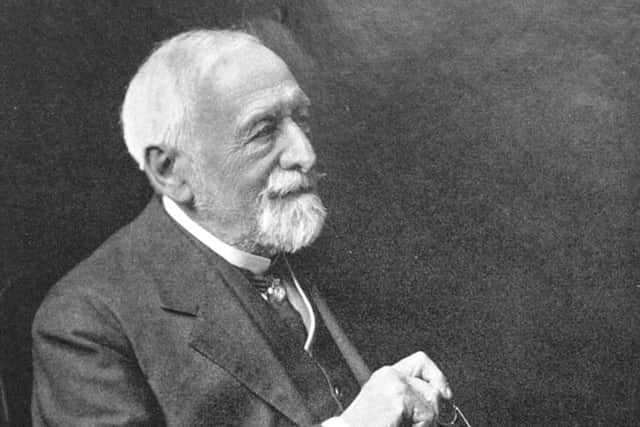Nostalgia with Margaret Watson: Honouring Dewsbury’s finest
and live on Freeview channel 276
Margaret Watson writes: They have already planted more than 100 trees on grassland betwixt Wakefield Road and Owl Lane with appropriate plaques attached.
They are also compiling an honours board to be erected in Dewsbury Town Hall bearing the names of illustrious sons and daughters of Dewsbury who have brought honour to the town.
Advertisement
Hide AdAdvertisement
Hide AdThe board will also include the names of those who lived or worked here, who made their mark in their chosen careers.


In the coming weeks, I hope to write more about these people and also something of the history of Dewsbury Rotary Club and the great work it has done in the town and also for local and international charities.
But this week I am concentrating on looking at some of the history of those whose names will be on Rotary’s honours board.
The foremost of these must surely be two men who were both born in Dewsbury and both attended the same school – St John’s C of E School, Dewsbury Moor – Sir Thomas Clifford Allbutt and Sir Owen Willans Richardson.
Advertisement
Hide AdAdvertisement
Hide AdSir Clifford, who was born in 1836, was one of England’s most outstanding physicians and a worldwide expert in the treatment of heart disease, tuberculosis, blood pressure and the circulatory system.
He invented the short clinical thermometer – the value of which can scarcely be overestimated – and also pioneered the use of the hypodermic syringe, morphine by injection in acute heart failure and “open air” treatment for typhoid victims.
All these were regarded as daring and radical treatments at the time, the latter drastically reducing the death rate from typhoid fever.
A great humanist, scholar and physician, Sir Clifford was Dewsbury’s most illustrious son, who, on leaving St John’s School, was educated at St Peter’s School, York, and also Cambridge University, where he studied science.
Advertisement
Hide AdAdvertisement
Hide AdHis father, Reverend Thomas Allbutt, was Vicar of Dewsbury Parish Church from 1835 to 1862, and his mother, Marianne, was the sister of Margaret Wooler, of Dewsbury, who taught Charlotte, Emily and Anne Bronte.
Sir Clifford met the Bronte sisters on a number of occasions when they visited the vicarage at Dewsbury, where their father, Reverend Patrick Bronte, had been curate some years earlier.
The Bronte sisters often visited the vicarage to have tea with the Allbutt family, and they also attended the church at various times, although St John‘s Church, Dewsbury Moor, was their regular place of worship.
For this was the church nearer to their school, Healds House on Healds Road, which was run by Margaret Wooler, Mrs Allbutt’s sister, and Sir Clifford’s aunt.
Advertisement
Hide AdAdvertisement
Hide AdThis was the school where Charlotte taught, and where her sister Anne was a pupil.
Sir Clifford also became a friend of the writer George Eliot, who took him as a model for her character Dr Tertius Lydgate in her novel Middlemarch, which was televised as a series some years ago.
Sir Clifford’s first senior appointment was as physician to the Leeds House of Recovery, and two years later he was elected to a similar post at Leeds General Infirmary.
Other appointments quickly followed, and during his long and successful career, spanning 65 years, he affected many drastic reforms in medicine.
Advertisement
Hide AdAdvertisement
Hide AdHe also held many prestigious positions, including President of the British Medical Association, Regius Professor of Physics at Cambridge University, a Knight Commander of the Order of the Bath and a Privy Councillor.
In 1889 he moved to London to take up the post of Commissioner in Lunacy, but he always deplored the use of the words “lunatic” and “asylum” in normal use in those days.
A kind and compassionate man, Sir Clifford campaigned relentlessly on behalf of the mentally ill.
Numerous degrees and titles were conferred on him, but he always only used his middle name, Clifford, and even after receiving his knighthood, continued to sign himself simply as “Clifford Allbutt”.
Advertisement
Hide AdAdvertisement
Hide AdIn 1909, he visited Dewsbury to open a new operating theatre and nurses’ home at the former Dewsbury Infirmary on Halifax Road.
This building was later converted into apartments named after another “Dewsbury Great”, Baroness Betty Boothroyd, first woman Speaker in the House of Commons.
Sir Clifford’s last visit to Dewsbury was in 1920 when he preached the evening sermon in Dewsbury Parish Church where his father had been vicar.
The service was to celebrate the festival of All Saints, in which Sir Clifford pointed out that sainthood depended upon the inward life.
Advertisement
Hide AdAdvertisement
Hide AdDewsbury’s most illustrious son remained active until his death in 1925 at the age of 88.
Another famous son of Dewsbury, Sir Owen Willans Richardson, like Sir Clifford, went on to bring great honour to the town.
He was awarded the Nobel Prize for Physics in 1928 and also discovered a law in physics which still bears his name - “Richardson’s Law”.
It was to become an important aid in electron-tube research and technology, making possible the rapid development of radio, telephony, television and x-ray technology.
Advertisement
Hide AdAdvertisement
Hide AdBorn in 1879, he was the only son of Joshua Henry and Charlotte Maria Richardson, of Blenheim Terrace, Dewsbury.
Sir Owen began to show his scientific inclinations and qualities at an early age, winning a scholarship to attend Batley Grammar School when he was 12.
Encouraged by his father, a woollen manufacturer in Dewsbury, the young Richardson did remarkably well in physics and chemistry.
Later, he gained a first class honours degree in natural science at the universities of Cambridge and London – with particular distinctions in physics and chemistry.
In coming weeks I hope to write more about his work, especially his important work during the two world wars.